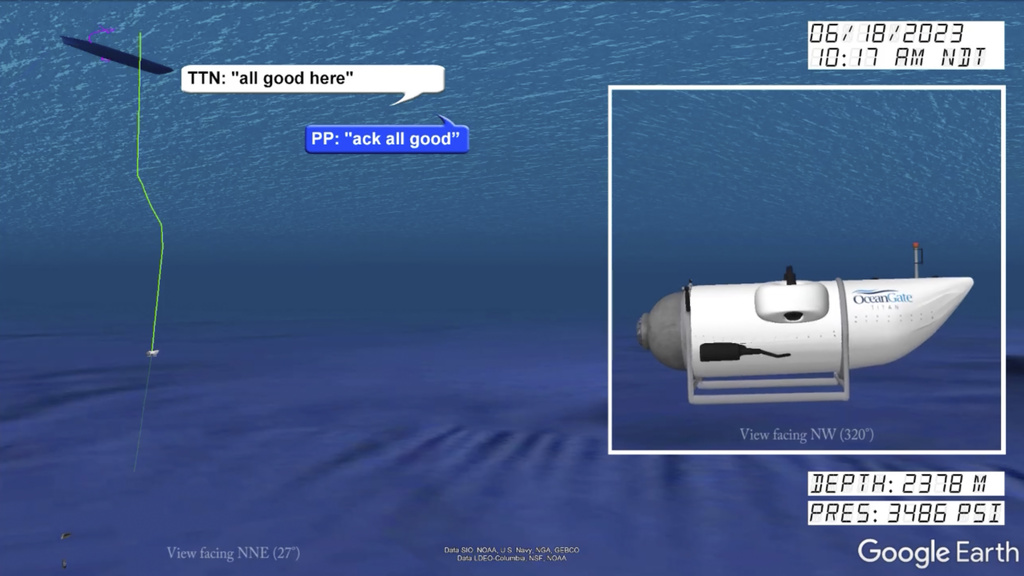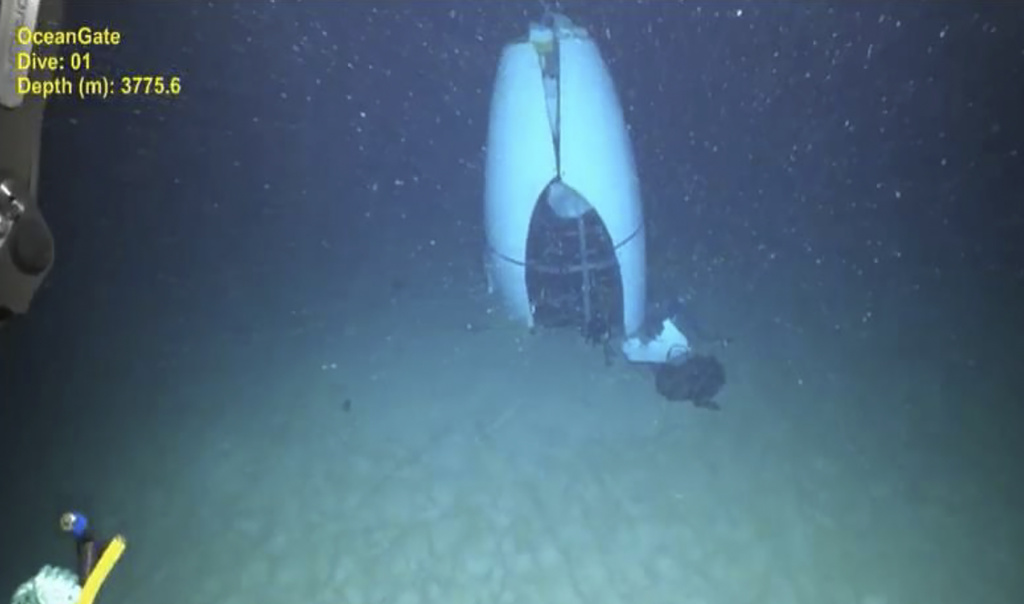OceanGate Co-Founder Defends Submersible Vision After Disaster \ Newslooks \ Washington DC \ Mary Sidiqi \ Evening Edition \ OceanGate co-founder Guillermo Sohnlein testified before a Coast Guard panel, expressing hope that the tragic implosion of the Titan submersible in June 2023 wouldn’t halt deep-sea exploration. Sohnlein, who left OceanGate before the disaster, emphasized the company’s mission to expand ocean access and discussed the choice of carbon fiber for the sub’s design. The hearing also featured testimony highlighting internal conflicts at OceanGate and scrutiny over its operational practices.

OceanGate Co-Founder Testifies After Titan Implosion Quick Looks
- Exploration Focus: OceanGate co-founder Guillermo Sohnlein stressed that the Titan tragedy should not be the end of deep-sea exploration, as the company aimed to create affordable, untethered submersibles.
- Carbon Fiber Decision: Sohnlein defended the use of carbon fiber in the submersible’s design, saying the goal was to make the vessel lightweight and cost-effective, despite safety concerns raised during the hearing.
- Internal Company Tensions: Testimonies revealed internal conflicts, including disputes over safety and financial priorities, with some former employees suggesting OceanGate was too focused on profits over science.
- Disaster Timeline: The Titan lost contact during its June 2023 dive, and debris was later found near the Titanic wreckage, killing all five aboard and igniting global debates on private undersea exploration.
- Regulatory Gaps: The hearing revealed that the Titan had not undergone independent review, prompting scrutiny of OceanGate’s unconventional designs and raising questions about oversight in deep-sea exploration.
Deep Look
The Titan submersible disaster, which claimed the lives of five people, including OceanGate co-founder Stockton Rush, continues to be the focus of a Coast Guard hearing aiming to determine the causes of the tragic implosion that occurred during a dive to the Titanic wreckage in June 2023. On Monday, Guillermo Sohnlein, the co-founder of OceanGate, testified before the Coast Guard panel, offering insights into the company’s mission, decisions, and vision for deep-sea exploration despite the disaster.
Sohnlein, who left OceanGate years before the Titan tragedy, shared his hopes that the disaster would not deter future explorations of the world’s oceans. “This can’t be the end of deep ocean exploration,” Sohnlein said, speaking about the importance of expanding humanity’s reach into the deep seas. He emphasized that both he and Stockton Rush envisioned a fleet of submersibles capable of diving as deep as 6,000 meters (6,500 yards) without requiring a dedicated mothership. This, Sohnlein explained, was an attempt to lower operational costs and make ocean exploration more accessible.
The hearing also provided an opportunity for Sohnlein to address OceanGate’s choice of materials for the Titan submersible, particularly the controversial use of carbon fiber in its design. He defended the decision, explaining that carbon fiber was chosen because it allowed the submersible to be lightweight, affordable, and free from the need to tether to a large support vessel. “Using carbon fiber wasn’t a novel idea,” Sohnlein argued, noting that others had previously explored its use in deep-sea vehicles. However, testimony from other experts during the hearing revealed concerns about the material’s reliability under extreme pressure, highlighting that carbon fiber is susceptible to fatigue failure during repeated dives.
Although Sohnlein was no longer with OceanGate when the Titan imploded, his testimony shed light on the company’s operational philosophy. He expressed confidence in Rush’s leadership and passion for deep-sea exploration but revealed that he had declined multiple offers to dive in the Titan himself. Sohnlein said he didn’t want to occupy a space that could be filled by paying customers and that Rush, who designed the submersible, felt a personal responsibility to pilot the vessel for its initial crewed dives. “If anything happens, I want it to impact me,” Rush reportedly said to Sohnlein, underscoring his commitment to the project.
The hearing has drawn attention not only to the technical aspects of the Titan’s design but also to internal tensions within OceanGate. Former OceanGate operations director David Lochridge testified earlier in the hearing, describing conflicts with Rush and expressing concerns that the company prioritized profit over safety. “The whole idea behind the company was to make money,” Lochridge stated, adding that there was little emphasis on scientific research. This sentiment was echoed by others who worked at OceanGate, including Phil Brooks, a former engineering director, who described being the first to analyze data from Titan’s dives and said Rush had the final authority on whether the hull was fit for future dives.
The hearing also revealed broader concerns about oversight in the field of private deep-sea exploration. Officials from the Coast Guard noted that the Titan had not undergone independent review, a standard practice for most submersibles. This lack of oversight has led to scrutiny within the deep-sea exploration community, with many questioning the safety standards of OceanGate and other similar companies. Several witnesses testified that there was pressure to expedite the submersible’s launch, sometimes at the expense of thorough safety checks.
Despite the growing concerns, Sohnlein remained steadfast in defending the company’s mission to push the boundaries of ocean exploration. He explained that OceanGate was built on the idea of giving humanity greater access to the deep ocean, a passion that both he and Rush shared. “We were never driven by tourism,” Sohnlein testified, adding that neither he nor Rush was particularly interested in the Titanic wreck itself, which had been extensively explored by others.
In contrast, other testimony painted a picture of a troubled company, eager to make a name for itself in the highly competitive world of deep-sea exploration. Tony Nissen, an earlier engineering director at OceanGate, testified that he felt pressured to get the vessel ready for dives and refused to pilot it on one occasion because he didn’t believe it was ready for the mission. Nissen also described Rush as difficult to work with, saying the founder was deeply concerned with cutting costs and meeting project deadlines.
The public hearing, which is expected to continue through Friday, will delve deeper into the technical issues surrounding the Titan’s design and the series of decisions that led to the disaster. Roy Thomas, of the American Bureau of Shipping, provided testimony detailing the challenges of using carbon fiber as a construction material, emphasizing that it is prone to failure under repeated pressurization—a critical concern for submersibles operating at extreme depths. The hearing will also examine why OceanGate did not pursue more rigorous testing and why it resisted undergoing independent reviews.
The Titan tragedy sparked global debates about the future of private undersea exploration and raised fundamental questions about the ethics of adventure tourism in dangerous environments. With growing interest in exploring the deepest parts of the ocean, the disaster has prompted a reevaluation of the risks involved and the need for stricter safety regulations. While OceanGate has suspended its operations since the disaster, the company continues to be represented in the hearings, and questions about the future of deep-sea exploration remain central to the discussions.
During its ill-fated dive on June 18, 2023, the Titan submersible lost contact with its support ship, Polar Prince, after exchanging text messages about the sub’s depth and weight. One of the final messages from the crew, recreated in testimony, stated, “all good here.” However, just moments later, the submersible imploded, and wreckage was found near the Titanic site days later. None of the five people aboard survived.
Despite the tragedy, Sohnlein remains optimistic about the potential for future innovations in deep-sea exploration. He hopes that the lessons learned from the Titan disaster will lead to advancements in submersible technology and inspire others to continue pushing the limits of what’s possible in the deep ocean.







